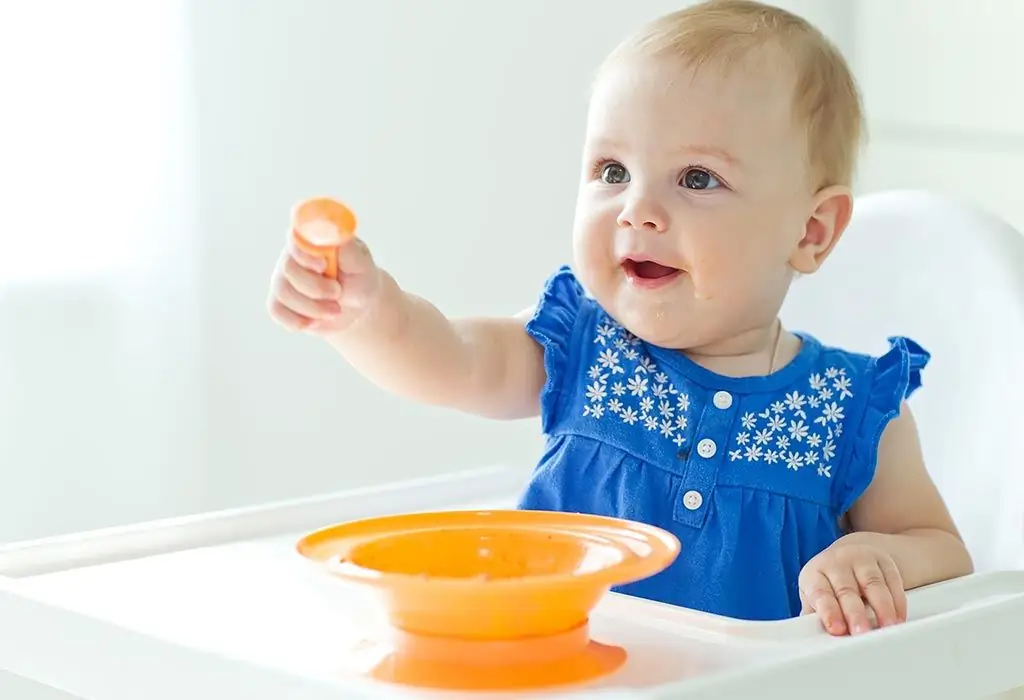2025 Author: Priscilla Miln | [email protected]. Last modified: 2025-06-01 05:14:29
When purchasing a small four-legged friend, you should know that the physical activity and state of his he alth depend on the feeding and maintenance of the puppy. Therefore, it is very important to provide the pet with the correct regimen and a complete diet, starting from the very first days of life. Not all dog owners know how to do it right. Below we will talk in more detail about how to organize proper nutrition for puppies from 1 month old.
The first days of life
In the first two weeks of life, puppies eat only mother's milk. During this period, it is necessary to ensure the nutritional value and calorie content of the diet of the nursing dog. If she does not have enough milk, the cubs can be placed on another lactating bitch. The fact that it is not enough is indicated by the anxiety of the litter: puppies sleep little and poorly, squeak, crawl and whine. Well-fed puppies fall asleep immediately after feeding and sleep long and soundly. A clear indicator that there is enough milk is the constant increase in their weight. Cubs must definitely receive colostrum after birth, otherwise the risk of death of the litter is high.

In the absence of a mother, puppies are fed with dog milk replacer purchased at a pet store or veterinary clinic. The procedure is carried out using a bottle and pacifier.
If the mother is kept with the puppies, then they should always be able to suckle when they want to eat. If a bitch is separated from her litter for any reason, then they should be fed at least 12 times a day.
Feeding puppies from 1 month old
As a rule, experienced breeders sell puppies after 1.5 months of their life. In some kennels, you can buy a puppy not earlier than 3-4 months, after the end of the vaccination quarantine. However, in some cases, for example, when a pet is sold without documents, the owners start selling the litter as early as 1 month.
Feeding a puppy at this age should not be difficult for the owner. Most often, breeders start feeding babies from three weeks old so that they themselves can eat from a bowl. But bringing a pet into the house, you need to prepare the necessary minimum of food for several days.

This list includes:
- buckwheat, oatmeal, rice;
- chicken, beef;
- offal;
- carrot, pumpkin;
- kefir, milk, cottage cheese and semolina.
When to feed
You should also observe the feeding time of the puppy, he must be given food every three hours. It is best to offer your pet a different meal each time. Approximate diet:
- 6:00 - semolina porridge;
- 9:00 - oatmeal porridgewith meat or carrots;
- 12:00 - cottage cheese with kefir;
- 15:00 - rice porridge with offal and vegetables;
- 18:00 - buckwheat or rice with meat and vegetables;
- 21:00 - semolina porridge.
What food should be
How to serve food for feeding puppies from 1 month old? You should know that all meals of the diet should be heavily chopped. But at the same time, you should not grind the products in a blender. The puppy must learn to chew food.
Initially, meat products are boiled, but after a week the meat can already be served raw in two out of three feedings. Food should not be hot or cold, the best option is food at room temperature.
It is important to know the portions of feeding puppies. The amount of food for a monthly pet per day is calculated based on the breed, large dogs need more food.
Feeding at 1.5-2 months

Most often it is at this age that the cub is taken away from its mother and given away or sold. In the new house, bowls and toys are already prepared for him. A warm and soft place is waiting for the baby. And at this moment, the future owner has a question how to ensure proper feeding of a 2-month-old puppy.
His diet should resemble feeding from a breeder: meat, cereals, milk and soups. A couple of times a week, you can offer boiled and boned lean fish, washed and chopped vegetables (zucchini, cucumbers, carrots, tomatoes, pumpkin). Trained from early childhood, the puppy will be happy to eat them when he grows up.
Feeding a 3-5 month old puppy
Thanto feed a puppy at three months or older? At this age, the diet remains the same. It is also based on dairy products and meat, as the main sources of animal protein necessary for a young body. Protein can also be obtained from fish, but it is not recommended to give it too often. Fruits, vegetables and grains are sources of vitamins and carbohydrates.
Additionally, pets can be given nutritional supplements (meat and bone meal, blood meal, fish meal) and fats (linseed, sunflower and pumpkin oil, fish oil). In the same period, the puppy should get acquainted with the boiled lungs and liver, as well as with the scar and marrow bones (to strengthen the teeth). In addition, chicken and beef are introduced.
How often to feed
In order for a pet to receive the amount of nutrients it needs per day, an optimal puppy feeding schedule should be drawn up. How often to give food depends on the age of the animal. The younger he is, the more often he should eat small portions. With age, the number of meals is reduced, and the amount of food is increased. All this helps to divide the daily diet into optimal parts.
Feeding a puppy from one to two months old should take place every three hours. At the age of three months, the dog eats 4-5 times a day, at six months - 3-4 times a day, and after the first year, the pet is transferred to two meals a day.
The reason for frequent feeding of a puppy at the age of one month is a small stomach, which is not able to accommodate the required amount of food, but a growing body requires a large number of calories.
Basic rules

Regardless of your pet's meal plan and feeding schedule, there are some rules to follow:
- The feeding portion of any puppy should contain the amount of food, according to the size of the baby.
- Serving increases according to age.
- The menu must include fermented milk and vegetable dishes.
- Until three months it is not recommended to feed babies with dry food. If you need dry food, you should buy food specifically for dogs from one month old.
- The bowl of food should be given no more than 15 minutes. This will help to teach the animal to discipline. The water cup does not need to be removed.
- For the same reason, feeding should be done at a strictly defined time.
- When a new product is introduced, it is given in small portions.
- After the baby has eaten, he needs to give a little time to rest, after which he can start active games.
- It is forbidden to alternate natural and dry food.
- The schedule should include fasting days a couple of times a month.
- Gradually, different additives can be introduced into the menu: chalk, fish oil.
The puppy's feeding regime directly affects his he alth, no less than heredity. In this regard, it is important to select food, in accordance with the individual and age characteristics of the pet.
Small breeds
Almost all small dogs are predisposed to diseases of the heart and blood vessels. Therefore, puppies of York, Toy Terrier, Chihuahua, Pekingese and other small breeds from smallage, you need to give a large amount of vitamin complementary foods. In addition, the menu of such a dog should be well balanced.
Puppies of small breeds are required to provide complete complementary foods with vitamin supplements containing an increased amount of fluorine and calcium. This is due to the peculiarity of the structure of a very vulnerable and long spine, which must have time to get stronger in a short period of time. You can't make up for poor quality food by increasing portions.
Feeding medium breed puppies

These dogs require more essential nutrients and energy than a small breed puppy. But much less than a large breed pet. The nutritional needs of such an animal can be covered by already balanced and ready-made feeds, which have an average content of minerals, vitamins and nutrients.
Experienced breeders know that premium dry and holistic foods contain balanced and optimal amounts of fat, protein, digestible fiber, minerals, vitamins and carbohydrates. This allows the owner of a medium breed puppy not to buy additional expensive food supplements.
It is important to know that excess or, conversely, insufficient amounts of vitamins and minerals are bad for the development and growth of the dog. And a diet with a high protein content causes an imbalance in the volume of calcium and phosphorus in the pet's body.
Large Breeds
Features of the norms of feeding a puppy of a shepherd dog, Labrador,huskies, alabai, huskies and other dogs of large breeds are in an increased amount of protein compounds. Low-fat meats in this case should be combined with boiled or stewed vegetables. This food is best given to your puppy at bedtime and only in small portions.
With a properly composed diet, a large breed pet should gain about 150 grams of weight every day. It is allowed to use both ready-made industrial feeds and natural food. Ready-made food should be intended for puppies of large breeds of dogs. To understand how much food to give the animal at a time, you should divide the amount indicated on the package per day by the number of feedings.
You should be aware that large breeds are prone to joint diseases, so do not overfeed the animal at an early age.
What not to feed
There are not so many foods forbidden for puppies, but they should be taken into account when compiling a menu for a dog. In one month, fresh cow's milk, liquid milk porridge, fresh wheat bread, pasta and potatoes are absolutely contraindicated for pets.
Puppies, regardless of breed and age, should not be fed raw chicken meat, raw river fish, chicken bones and sausage. In addition, the dog is forbidden to give marinades, smoked meats, pickles and fried meat products. Fatty, sweet, rich and s alty foods are also contraindicated.
Bulldog

Bulldog puppies are big lovers of good food, so it is important to watch the masspet body. Feeding a dog in the first month of life is also six servings and observing the same time intervals between meals. The diet itself should be varied.
Raw food is a must for a bulldog puppy because it contains more minerals and vitamins. Like other dogs, the Bulldog should not be given too hot or too cold food. The optimum food temperature is from +35 °C to +37 °C. The diet of a monthly puppy includes: fish, offal, soups, cereals, vegetables and dairy products.
Mastiff: feeding features

Mastiff puppy is a large dog breed. The weight of an adult reaches ninety kilograms. In this regard, the formation of the backbone is important. A pet at the age of one month must necessarily receive a complex of vitamins and minerals. The dog's diet must be properly balanced.
The diet of a one-month-old mastiff puppy includes the following foods:
- chicken, beef, rabbit, turkey (meat);
- kefir and cottage cheese (no milk, only fermented milk products);
- buckwheat, rice (cereals);
- quail eggs;
- greens, carrots, bell peppers, cabbage(vegetables).
Besides this, supplements from vitamins and minerals are added to the list of products. Most often, when purchasing a mastiff puppy, the breeder voices the recommended menu and the number of feedings. Usually the dog is given food five times a day.
Switching to dry food

If necessary, transfer the puppy to dry feeding, this should be done gradually. Otherwise, the puppy's stomach will not withstand the abrupt transition, and therefore problems in the body may begin.
Industrial dry food must be selected only at the highest level. The best rations in this segment include: "Pro plan", "Dog Chow", "Yakanuba", "Hills", "Pro Pak" and others.
After the dog is completely transferred to such a diet, natural food should be completely excluded from the diet. For many owners, it is more convenient to buy commercial feed than to create a menu on their own.
Food should be fully consistent with the breed of the dog and its age. With a lack of vitamins in such a diet, additional mineral supplements should be purchased. There should always be a bowl of water next to the food bowl.
Conclusion
Feeding puppies from 1 month is due to a varied diet, which should contain the optimal ratio of all nutrients, vitamins and minerals. The diet should fully cover all the physiological needs of the baby. Only in this case, a strong and he althy four-legged friend will grow out of the pet.
Recommended:
Mode of a three-month-old baby on artificial, breastfeeding and mixed feeding

How can a three-month-old baby's regimen be? And is it needed at all? The daily routine is necessary for both the baby and his parents. This is useful and convenient: the baby is always well-fed, dry and clean, develops in accordance with age, and the mother can organize her day productively. You can (and should) start following a certain regimen already with a three-month-old baby
Artificial feeding of a newborn: norms, recommendations and regimen

Nature has come up with an amazing nutrient for babies - milk. As mammals, humans feed babies the same way. Breast milk is the ideal food for newborns. It contains all the necessary substances for the baby in the right amount. In addition, the mother's immune cells help the child to develop protective functions of the body. Unfortunately, breastfeeding is not always available. Therefore, man came up with mixtures for artificial feeding
2-month-old baby: daily routine. Development of a 2 month old baby

Here is your 2-month-old baby who has changed so much in such a short period of time that you no longer know what will happen next. From this article you will learn how to care for your little one, how the baby should develop properly, what daily routine suits him best
Feeding geese: breeding features, feeding norms and diet, advice from experienced farmers

What should be the feeding of geese for their full development and growth? This question is asked by every novice farmer. Birds are unpretentious to feed, but certain rules should be followed in order to make a balanced diet. Only in this case, you can avoid problems with the he alth of domestic birds. In addition, not all grass is suitable for geese - some plants are poisonous for these birds
Menu for an eight-month-old baby: diet and diet for breastfeeding and artificial feeding

What should be the menu of an eight-month-old baby? When is a particular product introduced if the child is bottle-fed? It is worth understanding this issue before taking action

